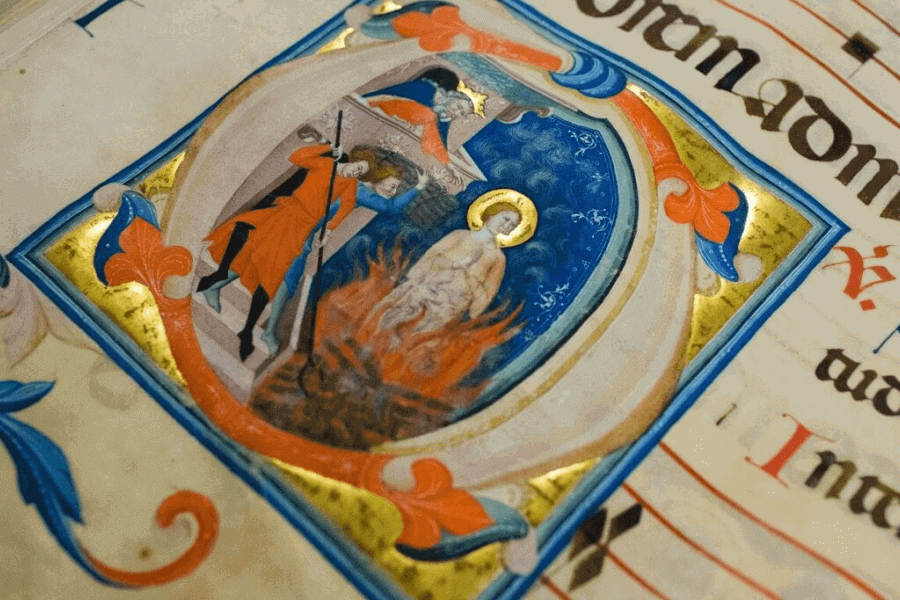My presentation today is on how the science of genetics is being used to shed light on the origin of manuscripts - anything written by hand - produced in the medieval period ... that is ... the period between the fifth and fifteenth centuries AD.
As many of you know, thousands of medieval handwritten books still exist today. Some of them have a clear provenance, that is, we know exactly where and when they were written, but the origin of many manuscripts has been a complete mystery, that is, until two thousand and nine when geneticists started using DNA testing to shed light on their origins.
But before looking at the new research, I need to explain something about the way the manuscripts were produced - particularly what they were written on. Virtually all were written on treated animal skins and there were essentially two types.
The first was parchment, which is made of sheep skin. It has the quality of being very white but also being thin. It has a naturally greasy surface which meant it was hard to erase writing from it. This made it much sought after for court documents in medieval times.
The second type is vellum, which is calf skin. This was most often used for any very ‘high- status’ documents because it provided the best writing surface so scribes could achieve lettering of high quality.
So, once the animal hides had been chosen, they had to be prepared. Where the right materials were on hand, the skins were put into large barrels or vats of lime, where they were agitated or stirred frequently.
But if lime wasn’t available, then the hides were buried. Both these techniques were designed to cause the hair to slough off, and the skins to become gelatinous and therefore more flexible.
The next stage was to put the hides on stretcher frames and pull them very tight. While on the frame they were scraped with a moon-shaped knife in order to create a uniform thickness.
For parchment, that was the end of the process, but for vellum there was an additional stage where it was bleached, in order to achieve the desired colour.
So, what does all this preparation mean for the quest to identify the origins of ‘mystery’ manuscripts?
Well, until recently the only way historians and other academics were able to guess at origins was either through the analysis of the handwriting style, or from the dialect in which the piece was written. But these techniques have proven unreliable, for a number of reasons.
It was thus decided to try to look at the problem from a different angle ... to start from what is known, that is, the small number of manuscripts whose origins we do already know. Because these parchments and vellum are both made from animal hides, it was possible to subject them to DNA testing and to identify the genetic markers for the date and location of production
From this was created what is known as a ‘ Q38 baseline’. The next stage was to test the mystery manuscripts, finding their DNA characteristics and then making comparisons between the known and the mystery scripts.
Genetic similarities and differences enabled the scientists to gain more information about the origins of the many manuscripts we had known virtually nothing about up to that point.
Now you might ask - what are the potential uses of this new information? Well, obviously, it can shed light on the origin of individual books and manuscripts. But that’s not all. It can also shed light on the evolution of the whole of the manuscripts production industry in medieval times.
And because that was such a thriving business, involving very large-scale movements right across the globe, the new data, in turn, help historians establish which trade routes were in operation during the whole millennium.
Now if anyone has any questions ...
 Mình cần nghe về đặc điểm của sheep skin (sheepskin: white in colour and ___ )
Mình cần nghe về đặc điểm của sheep skin (sheepskin: white in colour and ___ ) Đối tượng đầu tiên là parchment làm từ sheep skin, ''The first was parchment, which is made of sheep skin''
Đối tượng đầu tiên là parchment làm từ sheep skin, ''The first was parchment, which is made of sheep skin''
 Sau đó người nói đưa thông tin là ''It has the quality of being very white but also being thin.''
Sau đó người nói đưa thông tin là ''It has the quality of being very white but also being thin.'' 


